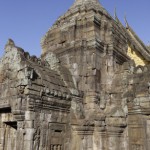The village of Ollantaytambo is where the roads end and where we boarded a train to reach Aguas Callientes (also known as Machupicchu Pueblo) , the township at the foot of the of ridge where the ancient city is located.
The whole area of Ollantaytambo village and fortress is a mid 15th century construction when the Pachacutec Inca conquered the area and added this strategic location to his personal estates. The village on the flat is still inhabited by people to this day. This village is a site of one of the few victories by the Inca over the Spaniards, when in In 1536, on the plain of Mascabamba, near Ollantaytambo, Manco Inca defeated a Spanish expedition, blocking their advance from a set of high terraces and flooding the plain. The victory blocked further Spanish advance along the Urubamba River valley.
The temple complex at Ollantaytambo was approximately 40 to 50% complete by the time the Spanish came, but all the same the workmanship of the completed temple walls was superb.

